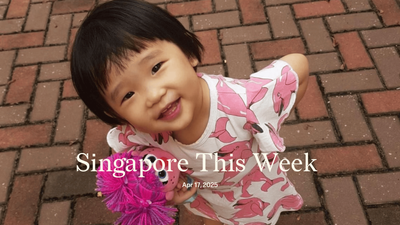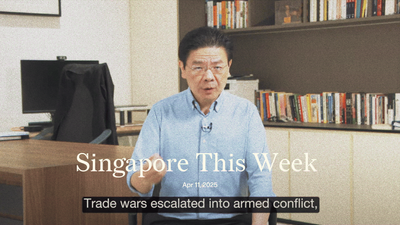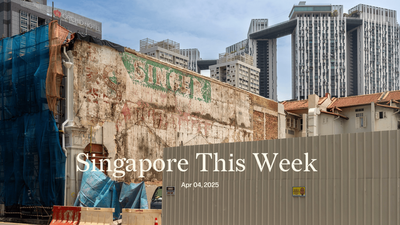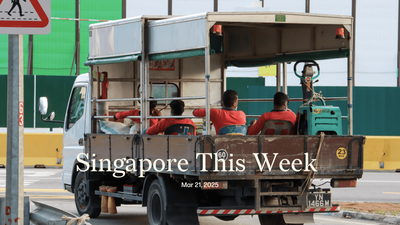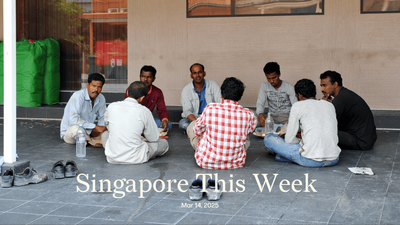Politics: Israel can, Myanmar cannot
Last May, Tom Andrews, the UN Special Rapporteur for Myanmar, released a bombshell 56-page report, “The Billion Dollar Death Trade: The International Arms Networks that Enable Human Rights Violations in Myanmar”. It alleged that US$254m (S$346m) worth of arms, raw materials and manufacturing equipment were shipped from Singapore to “the Myanmar military and Myanmar-based military suppliers” from February 2021, when the coup occurred, to December 2022. Singapore had the highest number of business entities accused of facilitating weapons and related material sales to the junta: 138, almost triple the number of companies in China and Russia combined. Singapore appeared focused on addressing the issue. But last December, further bad news emerged: three Myanmar nationals, including one on international sanctions lists, collectively tried to carry over half a million dollars through Changi Airport without declaring it. The Singapore Police Force (SPF) caught them, and they were fined a total of S$20,000. It’s unclear why he was subject only to a paltry fine. It is abhorrent that arms traders use Singapore as a base, and breeze in and out so easily.
But this week, things were looking up. Singapore is a “standout” in the global decline of weapons going to Myanmar, Andrews recently told CNA. “Singapore was at one point, the centre of financing [for] many of these military procurement transactions, controlling or processing 70 percent of them a year ago. That’s down to 20 percent,” he said. This is cause for some cheer. “Singapore’s policy is to prohibit the transfer of arms to Myanmar…” the Ministry of Foreign Affairs said in response. “At the same time, it is not the intention of the Singapore Government to block legitimate trade with Myanmar.”
Meanwhile, in a response this week to a parliamentary question about arms sales to Israel since October 7th 2023, Vivian Balakrishnan, minister for foreign affairs said: “Singapore complies strictly with our international obligations on international arms sales as well as UN sanctions and embargoes against any country, including submitting regular reports to the UN Register of Conventional Arms, which is a public record you can access for yourself. Apart from this, it is the established policy of the Government not to publicly divulge any details of defence sales for national security reasons.”
Some further reading: In “Is Singapore being used to finance wars?” we look at how arms traders from Russia, Myanmar, and North Korea use Singapore.
Society: The wrath of lao kok kok boomers
“The scorecard is bs leh. Simi protect sg. More like protect lao kok kok boomers with ancient thinking,” said Purpledragon84 on Reddit, in response to a new ranking of politicians based on how resistant they are to queer rights. Three politicians from the ruling People’s Action Party (PAP), including Lawrence Wong, prime minister, along with two from the Workers’ Party (WP) topped the ranking. The bottom five—the most strident defenders of queer rights—were all non-PAP members of Parliament. The ranking was published last week by Protect Singapore, a shadowy group that insidiously propagates religious conservatism under the banner of national interest. The group’s been buoyed, presumably, by its recent astroturfing campaign that prompted the Science Centre Singapore to cancel an adults-only event on sex and gender.
The religious right is also being propelled into action by the confluence of two trends. First, the growing acceptance of queer people. A majority of Singaporeans recently surveyed are in favour of legalising same-sex unions and adoption, as well as gender-affirming care (such as counselling and hormone replacement treatment) for teenagers with gender dysphoria, among other things. The second trend is the harsh reality that queer people continue to be systematically discriminated against in Singapore. At last week’s Pink Dot, Singapore’s de-facto pride parade, organisers released worrying results of a new survey: roughly half of queer students report discrimination at school; almost half of the queer community has experienced discrimination while job hunting; and a shocking 21 percent of transgender Singaporeans have been threatened or physically attacked.
So, on the one hand, Singaporean society, like every other rich, democratic one, is waking up to the gross injustices inflicted over decades on our queer community. On the other hand, Singapore, unlike most other rich, democratic ones, continues to be a terribly hostile place for them. This disjoint has created fertile ground for both queer rights activism and religious pushback. The mainstream media reported that numerous politicians showed up for Pink Dot despite the scorecard. Wong, Singapore’s first Christian leader who’s picked a Christian-heavy cabinet, is himself probably waking up to one of the thornier challenges of his early tenure. Will he be remembered as an inclusive leader, as he so often proclaims is his desire, or just another lao kok kok boomer?
Society: Conceiving baby-making narratives that include men
The perennial discussion around one of Singapore’s favourite topics has turned to men. Adrian Ang, the SGAG co-founder more commonly known as “Xiao Ming”, recently revealed his difficulties with infertility. Defined by the World Health Organization as a couple’s inability to conceive after 12 months or more of regular, unprotected sexual intercourse, infertility affects about one in six couples in Singapore. “When I started opening up [about my fertility challenges], I was surprised that many other couples, especially men, were going through the same thing, and many are suffering in silence by themselves,” he said, sharing his experience at a dialogue session on infertility organised by Fertility Support SG, a volunteer-run group started in 2020 by women dealing with infertility.
Most men, reportedly, find it hard to talk about fertility issues, due to feelings of shame, stress and stigma; believing that they have to conform to socially constructed notions of masculinity and fatherhood. A common refrain: “It made me feel less of a man knowing I may never be a dad.” Also, they often don’t have the level of community and systemic support that women do. Research indicates that infertility affects women more than men, even when the cause is male-related. “[M]any societies place the blame on women,” noted this study, which leaves many being incorrectly labelled “infertile”. Criticism of a recent Department of Statistics report that seemed to blame single women for Singapore’s flaccid fertility rate shows why this narrative is poor form, and has no place in society where both sexes have expressed reservations about having children. If couples are to get the physical and psychological therapy required to tackle causes of infertility, the problem must be approached as a gendered one as much as it is about reproductivity. As in other areas of gender rights, greater equality will benefit all. Ang and other males suffering in silence have patriarchal reproductive norms to blame for the stigma.
And dads, let’s talk about equal parenting; like not leaving your wife to care for the screaming kid, for starters. Closing the equal-parenting gap can bring benefits to all involved: fathers get to spend more time with their offspring and pursue non-work-related responsibilities; while mothers can focus on other aspects of their lives besides childcaring. Ultimately, a positive step towards achieving gender equality in both the workplace and at home.
Society: More sun, less screen
After ominous warnings from Vivek Murthy, the US surgeon general, about social media’s impact on children’s health, the Ministry of Health (MOH) will put “measures” in place regarding device usage for the young. It is unclear what shape these measures will take—some may worry about more regulation from an overzealous nanny state—and whom exactly they’ll target. An article by The Straits Times segmented the young into three groups: below 18 months old; between 18 months and six years old; and between seven and 12 years old. In any case the news is good insofar as it keeps an important conversation going. There’s a growing body of evidence suggesting that prolonged screen time among young kids can cause numerous developmental issues; among teens, social media usage can lead to negative body image, poor self-esteem and in extreme cases, self-harm.
Alarms bells about addictive technologies have been ringing for a while. In The Anxious Generation: How the Great Rewiring of Childhood Is Causing an Epidemic of Mental Illness, Jonathan Haidt, a social psychologist, claims that phones, and social media especially, have torn away huge chunks of time previously devoted to vitally formative activities like outdoor play, in-person conversations and even sleep. His most strident critics have accused him of creating a moral panic, mistaking correlation for causation, and generally behaving like a senior luddite in the face of new technology. Socrates thought writing could make humans ignorant.
Haidt does overstate his case at times. Yet, he is on to something, and not just with social media. As any parent who has watched their child disappear into the screen’s hallucinogenic abyss can attest, these technologies exert an almost narcotic pull on the young brain. That’s not surprising. If adults aren’t immune to Big Tech’s insidious moves, children, mimetic creatures that they are, can hardly be expected to resist. But cutting down on screen time through control—of the self and the child, as previous MOH advisories suggest—is not as simple as it sounds. The demands of an always-on work culture mean exhausted parents frequently give in to the temptation of pressing that remote button or tapping that app.
Singapore is an expensive society that exalts productivity while demanding that its citizens produce more children. For kids to then be brought up without technology’s crutch is a shift that may require systemic changes. Or, as one Reddit wit implied, just get them a phone with a Singtel connection.
History weekly by Faris Joraimi
Tributes rolled in over the past week to the late Syed Husin Ali, a scholar and man of the left, who passed away last week at 88. Born in 1936 in Johor, he was a 20-year-old undergraduate at the University of Malaya (UM) in Singapore when Nanyang University (“Nantah”) was founded. Syed Husin saw the interminable traffic jam on the road from Singapore town to Nantah’s Jurong campus for its inauguration ceremony. The following year, in 1957, Merdeka was proclaimed for the Federation of Malaya, launching Syed Husin into politics. He learned from the 20th century’s leading Malay nationalists—Ahmad Boestamam, Burhanuddin al-Helmy, and Ishak Haji Muhammad—who taught him the importance of continued struggle for the poor and marginalised even after independence was won. In 1965 Syed Husin and other young comrades took over the Malaysian People’s Party (PRM) leadership from Ahmad Boestamam, and renamed it the Malaysian Socialist People’s Party. (In 1989, its name reverted to PRM.) For his involvement in a peasant uprising in 1974, Syed Husin was detained without trial for six years under the Internal Security Act (ISA) and tortured. He had a critical role in the 2003 merger of PRM and the National Justice Party to form the People’s Justice Party (PKR), long associated with its current leader (and prime minister) Anwar Ibrahim.
As professor of sociology and anthropology in the ivory tower of UM, Syed Husin retained a class-based approach to Malay economic and social issues, critical of the traditional elites, sympathetic to workers and peasants. (His own family were aristocrats from the Sumatran sultanate of Siak.) True to his leanings, one of Syed Husin’s most recent works, A People’s History of Malaysia (2018), turns the spotlight away from tengkus, towkays, and colonial officials. It’s certainly in the mould of Howard Zinn’s A People’s History of the United States, following a trend of writing “history from below” popular in the 1980s. Kua Kia Soong, an activist and writer, had published A People’s History of Malaya the same year as Zinn’s book. As a fellow member of civil society, Kua recalls Syed Husin as a “rare, principled” comrade with a sense of humour. He lost all three elections he contested; why are the common, unprincipled, humourless ones better at winning?
Arts: Shooting her shot
The first Singaporean to oversee photography at London’s Tate Modern is training her lens on her first blockbuster exhibition there. Charmaine Toh, formerly senior curator with the National Gallery Singapore and programmes director with Objectifs – Centre for Photography and Film, is threading together visual narratives from across the planet for “Global Pictorialism”. She will be bringing together 50 artists in an attempt to capture a different perspective on the long sweep of “pictorialism”, the international art photography movement spanning the 1880s to the 1960s. “This kind of international collection allows me to really challenge the history of photography and the history of art, which I couldn’t really do in Singapore,” she told CNA. Long committed to alternative histories of photography, Toh has rehearsed for this moment. Her sprawling 2022 exhibition at our national gallery, “Living Pictures”, surveyed 150 years of South-east Asian photography, including what she described as a “war wall” confronting viewers with two parallel portrayals of the Vietnam War. One featured mostly unknown images from North Vietnamese photographers; the other, familiar images from some of the most prominent photojournalists of the western world. Visitors were prompted to reevaluate assumptions around “truthful and neutral depictions” of conflict, and to reorient our gaze away from the “trauma porn” of press photography (think, for example, of that searing image of a young Vietnamese girl, doused in napalm, running screaming towards the camera). Instead, the aperture of her curation shines a light on photographers such as Võ An Khánh, who travelled with a guerrilla army unit and documented the less visible work of scouts, medics, musicians and children sheltering in the country’s thick mangroves.
Toh joins a small but growing cluster of Singaporeans who have been appointed to high-flying positions abroad. These include the late Tan Boon Hui, a dynamic arts administrator who was director of New York’s Asia Society Museum, as well as curator Khairuddin Hori, who was deputy programming director at Palais de Tokyo, a Parisian centre for contemporary art. Tang Fu Kuen, itinerant dramaturg and curator, headed the Taipei Arts Festival before a stint as director of Norway’s BIT Teatergarasjen (BIT Theatre Garage). These border-crossing cultural leaders provide a counterpoint to the trend of parachuting in tried-and-tested civil servants to top-tier arts management positions back home. Toh’s new role, which she took up in March, offers her the rare chance to hone both her curatorial and her capability development by doing what artists in Singapore are best at: telling multiple Singapore Stories, instead of just the one.
Tech: Should Singaporeans’ monies be used to prop up SGX?
Despite Singapore’s reputation as a regional financial hub, local stock exchange activity continues to be lacklustre. In 2023, SGX’s turnover velocity, a measure of market liquidity, was only 36 percent. The corresponding figure for the Japan Exchange was 103.6 percent, suggesting that trades exceeded total market cap. Meanwhile the Hong Kong Stock Exchange recorded a turnover velocity of 57.35 percent in the same period. This has raised questions about whether GIC, Singapore’s sovereign wealth fund, should invest in locally listed companies to make Singapore’s equity market more attractive. After all, Japan and Australia both have pension funds which invest in local equities. However, Chee Hong Tat, Singapore’s second finance minister, is not in favour, citing potential conflicts with GIC’s primary objective of preserving and enhancing the international purchasing power of Singapore’s reserves. Chee said that GIC’s investments must prioritise long-term returns, without government interference. According to him, a more sustainable approach to market development involves fostering robust, SGX-listed Singaporean companies and supporting their global expansion to attract international investors.
Yet, this is a chicken and egg situation where poor trading volumes will continue to dampen SGX’s attractiveness to companies, Singaporean or not. Homegrown startups like Grab, PropertyGuru and Razer have all chosen to list overseas. This trend may persist until the government significantly shifts its stance on intervention in the local equity market.
Tech: The real winners of ride-hailing are the PHVs
In 2013, when Uber and Grab first launched here, they struggled to find enough drivers or cars to meet the demand, partly due to the exorbitant cost of owning a car. Enter Lumens, a private-hire vehicle (PHV) rental company that started renting out cars to aspiring gig workers who did not have one. Since launching with a mere four cars in 2014, Lumen’s fleet has grown to 3,000, thrice that of ComfortDelGro.
The money has followed. In 2022, Lumens recorded S$48.3m in revenue and S$5.14m in net profit, a 73 percent increase from the previous year. A year later, it doubled both top and bottom lines. The company has also expanded beyond its core PHV rental business, offering short-term rentals, car concierge services, and car sales and financing. This diversification has been crucial in driving growth and profitability. It has also pivoted to a hybrid vehicle fleet and has innovated in areas like collision damage waivers and healthcare packages for drivers. While Grab’s potential Trans-cab acquisition may increase competition in the PHV rental space, the persistent demand for vehicles in Singapore’s ride-hailing market suggests there’s still plenty of room for growth.
If you enjoy Jom’s work, do get a paid subscription today to support independent journalism in Singapore.



